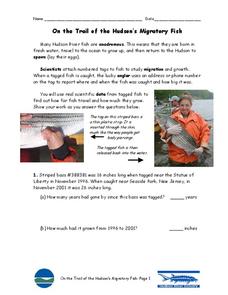Curated OER
Classification of Animals
This is one of the better presentations I've seen on the classification of animals. Youngsters view slides that introduce the characteristics of each of the animals groups through the use of photographs and text. Then, they are given...
Curated OER
On the Trail of the Hudson's Migratory Fish
Ever wonder how scientists track fish underwater? Your class can learn how with this informative worksheet. First, they will read a paragraph about androgynous fish, tagging, and data analysis. Then, your scientists must answer five...
Curated OER
What Class Are You In?
Classifying animals has never been this much fun! Pupils discuss the animal groups, fish, reptiles, amphibians, mammals, birds, and also identify their characteristics. Then, they take pictures of animals and classify them in a group...
Lakeshore Learning
Story Sequencing Activity
Pollywogs, tadpoles, and frogs. Here's a sequencing exercise that combines story telling and science. Kids paste illustrations of the life cycles of frogs in order on a story sheet.
K5 Learning
The Life Cycle
Studying plant, animal, or insect life cycles? Pair a science unit with a reading comprehension learning exercise on life cycles. The passage touches briefly on butterfly, plant, frog, and dog life cycles before prompting readers to...
Curated OER
Problem Solving: Guess and Check
Sometimes guess and check is the best way to solve a word problem. Learners use the guess and check strategy to solve each of the 6 included story problems. Note: At times younger children have difficulty using estimation or the guess...
Curated OER
A Climate Conundrum
After viewing a video and reading an article about the threatened turtles and tortises in The Amazon River area, collaborative groups create a poster or presentation about how we can help them. Several links to other related lesson plans...
Roland Park Country School
Butterfly or Moth?
What is the main difference between a moth and a butterfly? Butterflies have club-shaped antennae, while moths have a feather-like antennae. But what else differentiates these beautiful insects? The presentation in the resource provides...
Curated OER
Conservation in Small Spaces: Butterfly Life cycles
Students discuss ways that butterflies and moths change during their lifecycles, observe caterpillars, and explore how their different body parts work.
American Museum of Natural History
You are the Queen
A day in the life of a wasp queen is not as royal as it may sound. Pupils assume the role of the wasp queen to complete an interactive activity that simulates building a colony. They make decisions along the way and note the changes from...
Curated OER
Illustrating Proverbs
Explore some of the lesser-known proverbs from around the world. Here is a two-page worksheet with four Malay proverbs listed. For each proverb, the pupil must describe its lesson, think of any similar proverbs, and illustrate the...
K12 Reader
Dolphins
Dolphins are the focus of a short comprehension exercise that asks readers to identify the main idea and supporting ideas in the passage.
Calvin Crest Outdoor School
Survival
Equip young campers with important survival knowledge with a set of engaging lessons. Teammates work together to complete three outdoor activities, which include building a shelter, starting a campfire, and finding directions in the...
American Museum of Natural History
Wonderful World of Wasps
Shockingly, wasps sometimes challenge lions as the king of predators! Learners explore the life of a wasp in an interactive online lesson. They read about the characteristics of wasps and then complete activities to learn about their lives.
Curated OER
Reading Comprehension 8
What is a gall, and where is one typically located? Learn about this interesting insect home while reading this short passage. If you're looking to give your kids some test prep, this is a great resource for you! After reading the short...
Curated OER
Endangered Marine Turtles
Students work in groups and experience what it is like to be a hatchling marine turtle by playing a board game. For this endangered marine turtles lesson, students research the threats to marine turtle hatchlings. Students then create a...
Curated OER
A Lucky Break
Explore idioms with a chicken theme! Consider doing these activities prior to Thanksgiving, as there's a section about wishbones! First your youngsters will match a short list of idioms with their meanings. Then, give each learner the...
Organic Farming
Four Seasons
Celebrate the changing of the seasons with this collection of arts and crafts activities.
Teachnology
Paragraph Review
Writers are asked to examine four sentences that contain details and craft a topic sentence for a paragraph that encapsulates the main idea.
Teachit
Life Cycle of a Penguin
Celebrate the circle of life with this fun hands-on activity. After cutting out, gluing together, and assembling this visual model, learners are able to spin through and observe the life cycle of penguins.
Mr. Science
The Scientific Method
First, ask a question and then, do research. Next, form a hypothesis, and conduct an experiment. Make observations, gather and analyze data, and then state a conclusion based on the results. This is the scientific method, and here is a...
University of Maryland
Pollination
Sixteen ounces of honey requires more than 1,000 bees traveling over 100,000 miles and visiting 4.5 million flowers. The presentation includes sexual reproduction in plants, the parts and functions of a flower, pollination,...
American Museum of Natural History
Life in the City
Believe it or not, biodiversity exists even in areas of disturbed habitat. An interactive activity challenges learners to look for species with a magnifying lens in an image of a city habitat. Pop-up images and descriptions explain how...
American Museum of Natural History
Find My Plankton Baby Picture
Get a better understanding of babies in the sea. The class learns about the two kinds of plankton. They then determine the baby pictures of eight marine animals given a picture of the adult and some hints about the larvae. When scholars...

























